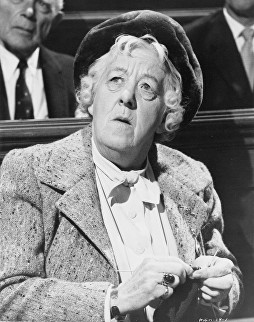




Four portrayals of Jane Marple: from left to right Joan Hickson, a 1950s fontana cover, Margaret Rutherford and Angela Lansbury; below her, Geraldine McEwan.
INTRODUCTION
Agatha Christie created two immortal characters in her books – M. Hercule Poirot and Miss Jane Marple. Some might say literally ‘immortal’, because both are in their 60s at least when they first appear and both are still going strong(ish) over 40 years later.
Lady Selina Hazy, in At Bertram’s Hotel (1966) observes: Why, I do believe that’s old Jane Marple. Thought she was dead years ago. Looks a hundred. Lady Selina is probably quite close to the mark.
Miss Marple first appeared in The Murder at the Vicarage in 1930. Her character was based on that of Caroline Sheppard from The Murder of Roger Ackroyd – someone who could “do any amount of finding out by sitting placidly at home”.
Agatha Christie said of Caroline: “I liked the part she played in village life …. I think at that moment, in St Mary Mead, though I did not know it, Miss Marple was born”. She also endowed her character with some of the abilities of her own Grandmother, in particular a sixth sense of what was happening and going to happen.
The first mention of Miss Marple is made by the vicar’s wife Griselda: … that terrible Miss Marple…. She’s the worst cat in the village. This (widely-shared) opinion has changed by the last line of the book: Really, Miss Marple is quite a dear …
Time and again in these stories she is initially dismissed as interfering and nosey by characters who end up being surprised by her astuteness and comforted by her common sense.
PORTRAYAL
When I first read a Miss Marple story, I could not get the image of the cartoonist Carl Giles’ Grandma out of my head – someone as unlike Miss Marple as could be imagined (apart from, maybe, her on-screen portrayal by Margaret Rutherford). At the time, in the 1960s, we used to get the Giles annual every Christmas and we loved it.
My over-riding image of her now, no matter which book I am re-reading, is of a frail old lady of 80 years or so, but one with all her faculties intact. She is slimmer than Giles’ Grandma, but still dressed in black, with lace rather than fox over her shoulders.
Time may pass in the world outside (during her career, staple characters of these stories, such as her dear nephew Raymond, court, get married and have children who grow to adulthood) but Miss Marple stays the same. The BBC’s excellent series covered every Marple novel and Joan Hickson’s portrayal in it is the now the definitive one.

METHOD
Miss Marple’s mantra is that human nature is much the same everywhere. She uses her memories of a long village life to provide local parallels that explain, to her if no-one else, the motivations and behaviours of the wider world. She never believes what she is told without confirmation of it (human nature being what it is), and so is never side-tracked by red herrings. She rarely bothers to follow up clues.
Miss Marple presents a slightly more believable geriatric sleuth than Poirot: by the end she has a live-in carer, can no longer tend her garden or see her knitting and for most of the time just sits, listens and observes. Her travels are usually paid for by others (dear Raymond), who make sure that she is properly looked after.
Miss Marple and Poirot are very dissimilar in character but have two important things in common. Neither have had children or even been in a close relationship, and both employ the same basic method: listen carefully to what people have to say, without believing a word of it, then sit back and think it through using the little grey cells or village parallels.
As with many older people, it is difficult to pull the wool over her eyes and this is what makes Miss Marple’s success credible.
THE BOOKS
The Marple stories are all relatively similar – a problem occurs and she is on hand or asked to solve it. There are no serial killers or maniacs bent on world domination of the kind that Poirot meets.
This cosy style was established by The Thirteen Problems (1932), which features six people sitting around a fireside, each narrating an unsolved mystery. One by one, ‘Aunt Jane’ solves them.
Reading, or re-reading a Marple story is best done with your feet up in front of a fire.